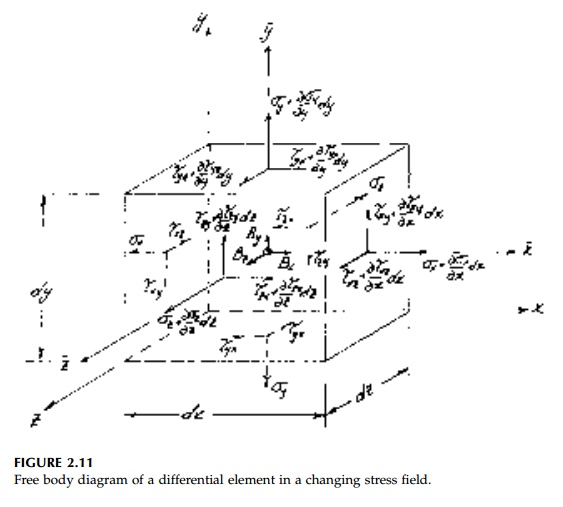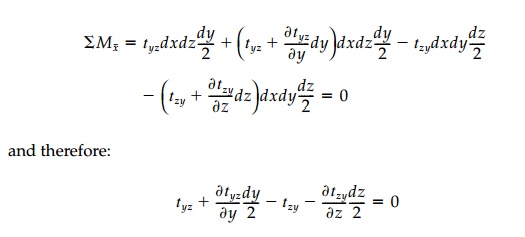Chapter: Civil : Principles of Solid Mechanics : Stress-Strain Relationships (Rheology)
Equilibrium of a Differential Element
Equilibrium of a Differential Element
So far we have
discussed the properties of the stress tensor and its transfor-mation with
various orientations of orthogonal axes by visualizing a 'state of stress at a
point' (a mathematical abstraction?). In general, in the loaded blob, stresses
change over differential base lengths and to discover how they change is a
primary reason that we study the mechanics of deformable solids in the first
place. For design, we would like to control how stress components change along
with their magnitudes, which is more difficult yet.
Consider first the free-body diagram of
a differential element in rectangu-lar orthogonal coordinates x,y,z
as shown in Figure 2.11. The body-force components Bx, By,
Bz (force per unit volume) include gravity, inertial effects

due to acceleration, magnetic fields,
etc. Summing forces in the x direction:

Summation of forces in the y and z
directions give similar results and the three equations of equilibrium are
thus:

For equilibrium of the element, the sum
of the moments with respect to any axis is also zero. If the centroidal axis x
parallel to x is considered first:

Similar equations result from taking
moments about the y and z axis. Since the terms involving
differentials can be made arbitrarily small, the three moment equilibrium
reduce to:

and the stress tensor is naturally
symmetric* as assumed in Section 2.3.
Equations (2.43), the
statement of F = ma on a
differential scale, are perhaps the most important ingredients in the theory of
the mechanics of deformable solids. They are field equations that apply
throughout the structure, whatever its geome-try and independent of what
material it is built of, the load level, or whether it is elastic, plastic,
viscoelastic, or whatever. They are the starting points for all solu-tions or
for design.
Unfortunately the differential equations
of equilibrium are not sufficient in themselves to solve for a unique stress
field for a given boundary loading. For three dimensions there are [with
Equations (2.44)], three equations and six unknowns. In the plane two-dimensional
case, the equilibrium equations reduce to:

which, with two equations and three
unknowns, are still insufficient. Only in the rare case of one dimension can
the remaining one equation of differential equilibrium with one unknown: d?x
/dx
+
Bx = 0 be integrated to
give a solution directly. Thus determining the stress field is inherently a
statically indeterminate problem.*
Related Topics